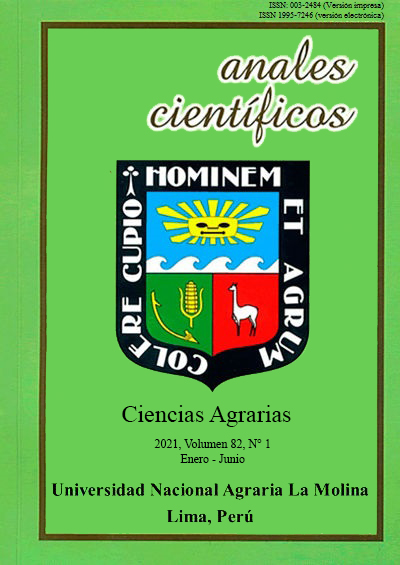LA NATURALEZA REPRESENTADA EN LOS DISEÑOS DEL PUEBLO AWAJÚN EN PERÚ
DOI:
https://doi.org/10.21704/ac.v82i1.1745Palabras clave:
Diseño indígena, arte indígena, pueblo Awajún.Resumen
El objetivo de la investigación fue describir los diseños del pueblo Awajún y su relación con la naturaleza. El estudio se realizó en 191 estudiantes de la institución educativa N°167411-B, Kusu Kubaim, ubicada en el Distrito Cenepa, Provincia Condorcanqui, Región Amazonas, Perú. La investigación fue descriptiva de alcance temporal y longitudinal; por su amplitud, es micro educativa; por su carácter, es mixta; por su naturaleza, es no experimental; por su marco, es de campo. Se utilizó un diseño descriptivo simple y técnicas de observación y entrevista; los instrumentos fueron ficha de observación y guía de entrevista. En conclusión, la característica principal de los Diseños de la Cultura Awajún son símbolos, pequeñas líneas y puntos que, por su modo, cantidad, forma y ubicación, dibujan diversos elementos de la naturaleza que influyen en la vida cotidiana del poblador Awajún, y cada símbolo atesora un significado, enseñanza, que guarda relación con los patrones de convivencia del pueblo Awajún y prevalecen tres colores (negro, rojo y blanco).
Descargas
Referencias
• Alvarez-Calderón, D. (2015). Cerámica Tradicional Awajún. Primera edición, Lima, setiembre de 2015. Impreso en los talleres de Punto y Grafía S.A.C Av. Del Río 113, Pueblo Libre, Lima.
• BDPI- Base de Datos de Pueblos Indígenas u Originarios. (2020). Awajín. Disponible en https://bdpi.cultura.gob.pe/pueblos/awajun
• Belaunde, L. (2009). Kené arte, ciencia y tradición en diseño. Editorial INC. Primera edición. ISBN: 978-9972-613-78-4. Instituto Nacional de Cultura Av. Javier Prado Este 2465 San Borja, Lima, Perú.
• Castillo, S. (2008). Grado de Conservación de los Relatos Orales Tradicionales en Mapuches Residentes En Tres Comuna De Santiago De Chile. Tesis para optar al grado de Magister en Lingüística con mención en Lengua Española. 2da edición, Editorial san Martin. Chile.
• Cosme, L., Mujat, N., & Nujigkus, E. (2019). Diseños Awajún en los estudiantes de la Institución Educativa Bilingüe N°16741-B, Kusu Kubaim en el 2015. Revista Innova Shinambo 1 (1), 17-34.
• Mujat, N., & Nujigkus, E. (2015). Diseños Awajún en los estudiantes de la Institución Educativa Bilingüe N°16741-b, Kusu Kubaim en el 2015. Tesis carrera profesional de Educación Primaria Bilingüe. Universidad Nacional Intercultural de la Amazonia. Pucallpa – Perú. 92 pp.
• Daggett, C. (1983). Las funciones del masato en la cultura Chayahuita. Anthropologica 1(1): 301-310. Disponible en http://revistas.pucp.edu.pe/index.php/anthropologica/article/view/6314
• Forero, J. (2010). Los cuentos de tradición oral como mecanismo de trasmisión de saberes ancestrales relacionados con la naturaleza, en comunidades de la microcuenca del río Chimborazo El Programa Bio Andes es financiado por la Agencia Suiza para el Desarrollo y la Cooperación, COSUDE.
• Juank, A. (1997). Ortografía Shuar y Apuntes de gramática y léxico Achuar. Segunda Edición, Fascículo 4, Editorial Vicaria del Pastoral Macas, Ecuador. 81 pp.
• López, P. (2000). Los Diseños Indígenas en los Ambientes del Instituto Superior Pedagógico Público Bilingüe de Yarinacocha y su influencia en la Práctica de la Interculturalidad del ISPPBY. Yarinacocha- Ucayali-ISPBY. Perú.
• Ministerio de Comercio Exterior. (2020). Ley de artesano y del desarrollo de la actividad artesanal.
• Regan, J. (2010). Los Awajún y Wampís contra el Estado: una reflexión sobre antropología política. Revista investigaciones sociales14(24), 19-35.
Descargas
Publicado
Número
Sección
Licencia
Derechos de autor 2021 Lida Cosme Solano, Nereo Mujat Kajekui, Elder Nujigkus Ampam, Nazario Aguirre Baique

Esta obra está bajo una licencia internacional Creative Commons Atribución-CompartirIgual 4.0.






